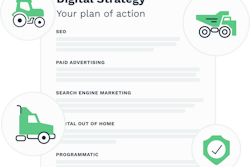
Uncertainty about freight opportunities and regulation bottomed out the new truck market in April but International President and CEO Mathias Carlbaum believes replacement demand will drive carriers back toward investment as the year progresses or stability returns, he said during a press event last month at the ACT Expo.
On location in Long Beach to introduce International’s first Class 8 electric tractor, Carlbaum said he believes many carriers came into the year expecting to add units. Orders were above historical averages in the final months of 2024 and expectations remained strong early in 2025.
But the economic tumult radiating from Washington D.C. and President Donald J. Trump’s trade battles has created a climate where buyers are apprehensive to enter into purchases without greater certainty about where the freight market will be when those new trucks arrive.
“Very many of our customers are a bit reluctant right now, to say the least,” he said.
[RELATED: International parent Traton's earnings detail softening truck demand]
With orders down and cancelations up, Carlbaum said International, like other OEMs, has been forced to throttle back production and downsize its workforce to support a leaner backlog. He said most of those cuts have occurred at the company’s Escobedo, Mexico, assembly plant, where cancelations have the largest impact.
“Production levels have been ticking down every month for the last three or four months,” he said.
But Carlbaum also believes today’s order climate is unique and could be short lived.
He cited the pre-buy that was expected to begin this quarter ahead of EPA 2027 regulations. Carlbaum said “zero to none” of that has happened yet but any clarity on the regulations (will it remain, be amended, repealed, etc.) will increase demand when it occurs.
Additionally, Carlbaum said there remains a large segment of carriers who are still trying to reset their trade cycles in the aftermath of the pandemic order boom and those fleets have a large crop of older trucks they need to replace.
“We have a lot of operators that used to operate the vehicles on four years that are now running on six years,” he said. “And, of course, when you come up another year on that, it comes to a point when replacement need will start to kick in.”
He actually believes some of that could occur independent of economic clarity, as carriers begin business planning into next year.
“Some definitions will need to happen in the coming two or three months,” he said. “That at least gives us the ability to make conscious decision of investments?”
As for now, Carlbaum is hopeful April’s numbers don’t extend much longer.
“The market right now, I would say we are close to the bottom,” he said. “The question is ‘How long [do] we stay at the bottom?’”
Carlbaum said the recovery will begin this year but year-end data might not look great.
“We see a flat, weak 2025 ahead of us. We believe 2026 will start picking up because of what I mentioned. And we do see, of course, the current [economic] situation is not going to stay as is,” he said. “We see 2026 coming up as a good year.”











